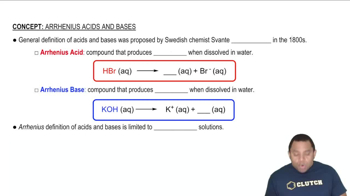Which of these statements about the common-ion effect is most correct? (a) The solubility of a salt MA is decreased in a solution that already contains either M+ or A-. (b) Common ions alter the equilibrium constant for the reaction of an ionic solid with water. (c) The common-ion effect does not apply to unusual ions like SO32 - . (d) The solubility of a salt MA is affected equally by the addition of either A- or a noncommon ion.
Ch.17 - Additional Aspects of Aqueous Equilibria

Brown15th EditionChemistry: The Central ScienceISBN: 9780137542970Not the one you use?Change textbook
Chapter 17, Problem 16
Use information from Appendix D to calculate the pH of: (a) a solution that is 0.250 M in sodium formate (HCOONa) and 0.100 M in formic acid (HCOOH); (b) a solution that is 0.510 M in pyridine (C5H5N) and 0.450 M in pyridinium chloride (C5H5NHCl); (c) a solution that is made by combining 55 mL of 0.050 M hydrofluoric acid with 125 mL of 0.10 M sodium fluoride.
 Verified step by step guidance
Verified step by step guidance1
Step 1: Identify the type of solution for each part of the problem. For (a) and (b), these are buffer solutions, and for (c), it involves mixing two solutions to form a buffer.
Step 2: For part (a), use the Henderson-Hasselbalch equation: \( \text{pH} = \text{pKa} + \log \left( \frac{[\text{A}^-]}{[\text{HA}]} \right) \). Identify \( \text{pKa} \) for formic acid from Appendix D, and use the concentrations of sodium formate and formic acid.
Step 3: For part (b), again use the Henderson-Hasselbalch equation. Identify \( \text{pKa} \) for pyridinium ion from Appendix D, and use the concentrations of pyridine and pyridinium chloride.
Step 4: For part (c), calculate the moles of hydrofluoric acid and sodium fluoride using their concentrations and volumes. Then, find the total volume of the solution after mixing.
Step 5: Use the Henderson-Hasselbalch equation for part (c) with the calculated concentrations of fluoride ion and hydrofluoric acid in the final solution. Identify \( \text{pKa} \) for hydrofluoric acid from Appendix D.
Key Concepts
Here are the essential concepts you must grasp in order to answer the question correctly.
Buffer Solutions
Buffer solutions are mixtures of a weak acid and its conjugate base or a weak base and its conjugate acid. They resist changes in pH when small amounts of acid or base are added. In the given question, sodium formate and formic acid form a buffer system, as do pyridine and pyridinium chloride, allowing for the calculation of pH using the Henderson-Hasselbalch equation.
Recommended video:
Guided course

Buffer Solutions
Henderson-Hasselbalch Equation
The Henderson-Hasselbalch equation is a mathematical formula used to calculate the pH of buffer solutions. It is expressed as pH = pKa + log([A-]/[HA]), where pKa is the negative logarithm of the acid dissociation constant, [A-] is the concentration of the conjugate base, and [HA] is the concentration of the weak acid. This equation is essential for determining the pH in the scenarios presented in the question.
Recommended video:
Guided course

Henderson-Hasselbalch Equation
Acid-Base Equilibria
Acid-base equilibria involve the balance between acids and bases in a solution, which can be described by their dissociation constants (Ka for acids and Kb for bases). Understanding these equilibria is crucial for calculating pH, especially when mixing solutions of weak acids and their salts, as seen in the hydrofluoric acid and sodium fluoride combination in the question.
Recommended video:
Guided course

Arrhenius Acids and Bases
Related Practice
Textbook Question
1
views
Textbook Question
Consider the equilibrium B(aq) + H2O(l) ⇌ HB+(aq) + OH–(aq). Suppose that a salt of HB+(aq) is added to a solution of B(aq) at equilibrium. (c) Will the pH of the solution increase, decrease, or stay the same?
1
views
Textbook Question
a. Calculate the percent ionization of 0.007 M butanoic acid (𝐾𝑎=1.5×10−5).
Textbook Question
(b) Calculate the percent ionization of 0.0075 M butanoic acid in a solution containing 0.085 M sodium butanoate.
2
views
Textbook Question
(a) Calculate the percent ionization of 0.125 M lactic acid (Ka = 1.4 × 10-4).
